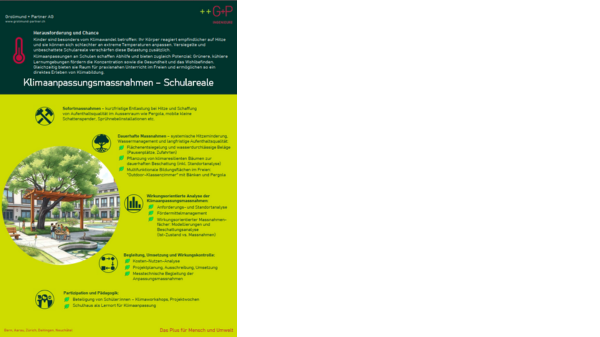Implementation Alone Is Not Enough – It Must Deliver Impact
Whether it’s a schoolyard, a play street or a new neighbourhood centre: the question is not only whether measures are implemented, but whether they have measurable impact. Cooling effects, rainwater retention, flood protection, quality of public spaces – all these aspects must be considered together and made verifiable. Only in this way can sustainable infrastructure be created that adapts to the challenges of the next 30 to 50 years.
Impact-Oriented Planning as a Success Factor
Grolimund + Partner offers cities and municipalities comprehensive support throughout the entire project cycle: from hotspot analysis to impact-driven planning of measures, through to implementation and monitoring of results. The focus is on both immediate measures for existing infrastructure and long-term adaptation concepts for new constructions or redevelopments.

Fact sheet on climate adaptation measures – school areas (available in German only). Click to enlarge.

Fact sheet on climate adaptation measures – sponge city (available in German only). Click to enlarge.
What Sets Us Apart: Making Impact Visible
With our extensive sensor park, we measure temperatures, humidity, soil moisture, albedo (reflectivity), evaporation and much more – in real time and site-specific. We process the results in a way that makes their benefits clear and effectively communicated to administrations, politicians and the public. This strengthens acceptance and creates transparency.

From Standards to Impact
Even if new projects formally comply with current standards, that doesn’t automatically mean they are climate-resilient. Developing climate-resilient cities is an iterative process where potential must be identified and systematically optimised based on impact-oriented analyses. This requires an overarching perspective that integrates urban climate, ecological, social and economic aspects – practical, concrete and evidence-based.
Proven, Sound and Interdisciplinary
Our team brings together expertise in climate adaptation, acoustics, air quality, civil engineering and energy. We already support over 20 cities and municipalities in Switzerland and integrate findings from research projects – for example, on cooling road surfaces or heat-reducing building materials – directly into your projects.
Conclusion
Cities and municipalities are under heat pressure. To turn strategies into effective measures, interdisciplinary support is essential – from analysis to impact measurement. Grolimund + Partner supports you with expertise and practical experience. Act now, achieve measurable impact and benefit from available funding. Get in touch with us.
/www.gundp.ch/file/2912/blog_klimawandel_kuehlende-parks.png)
/www.gundp.ch/file/2911/blog_klimawandel_vorher-nachher.png)
/www.gundp.ch/file/1845/Titelbild_Akustische_Kamera.jpg)
/www.gundp.ch/file/2370/Titelbild_LAB_LCA_v4.png)
/www.gundp.ch/file/2849/Data_Science_E.png)